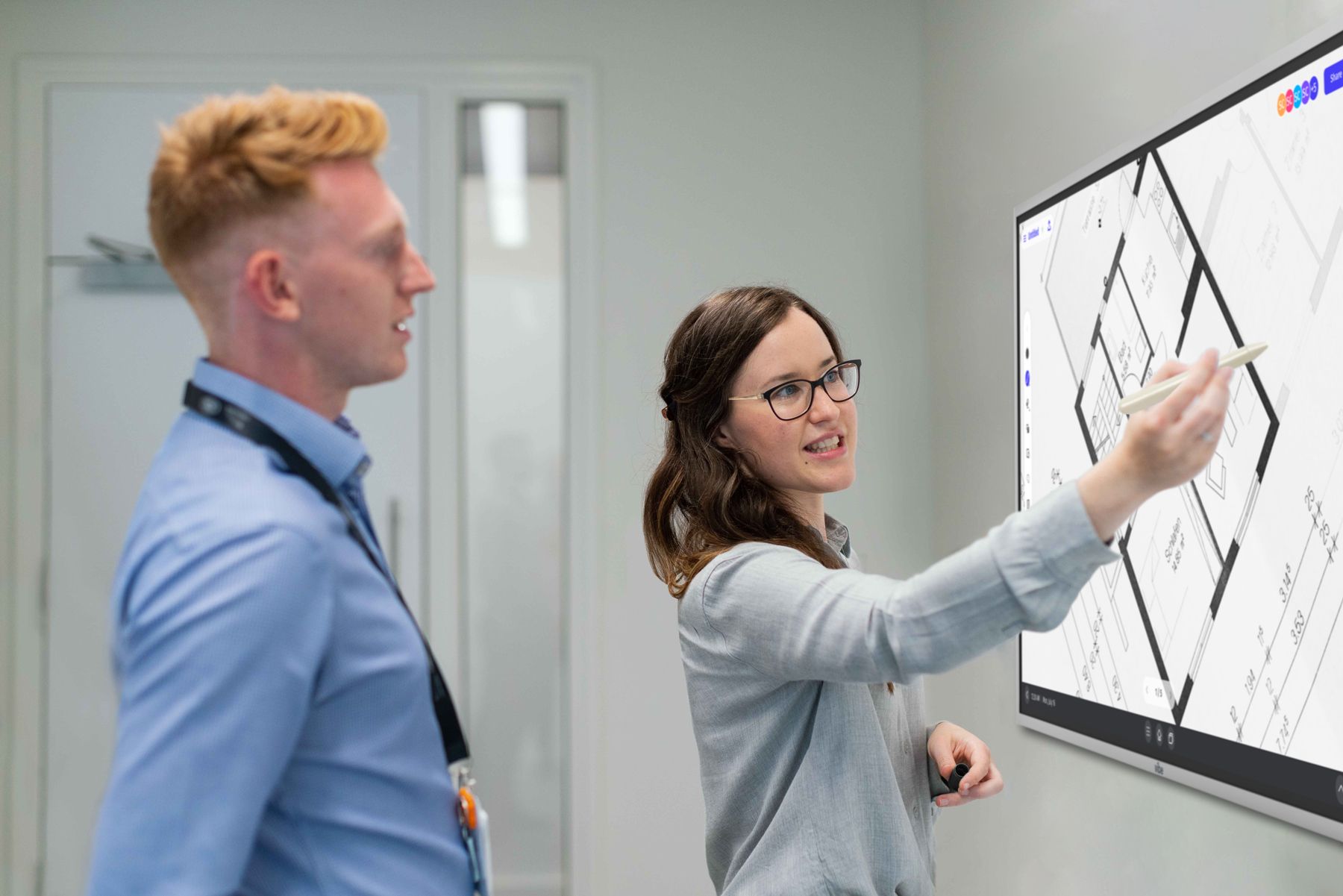Touchscreen displays are rapidly increasing in popularity and create a more modern and productive working environment. Significant improvements in touch interface technology’s accuracy have allowed touchscreens to evolve from clunky devices to sleek, straightforward tools.
There are many reasons for integrating touchscreen displays in your business. But how exactly does this seemingly "magical" technology work? This article will break down how touchscreens work, the kinds of touchscreens available, and some benefits of using touchscreen technology for your business or classroom collaboration.
How is a touchscreen different from a keyboard?
A touchscreen can be conceptualized as an invisible keyboard attached to the front of your computer monitor. To have a thorough comprehension of how it works, you must first understand how a standard keyboard works.
Every key on a keyboard works like an electrical switch. When you push a key, an electric circuit is completed, and the current flows. Your computer knows what you’re typing based on the type of keyboard. If you look inside a keyboard, you’ll see two layers of electrically conducting plastic separated by a plastic membrane with holes in it. There is a hole under each key. When you press a key, the top conductor layer is pushed down towards the bottom layer, so the two layers touch through the hole, completing a circuit. Touchscreens work on this premise, but with different technology.
Looking for innovative ways to collaborate? Order a Vibe Board today!
How touchscreens work
There are different kinds of touchscreen technology, which work in different ways. Certain types of touchscreens can only sense one finger at a time, while others are more sensitive. Different technologies also have different ways of dealing with wear and tear. Vibe Boards use infrared technology, which we will discuss below.
Resistive:
The most basic and standard touch screens you’ll come into contact with are resistive ones. These are the touchscreens used at supermarkets and ATMs when you sign something with a small grey pen. True to their name, these screens literally "resist" your touch. If you press hard enough, the screen will slightly bend. When you press down, two electrically conductive layers touch each other, just like in a regular keyboard, and complete a circuit when they touch. There is an electrical current running through the layers at all times, but when your finger hits the screen and the two are pressed together, the current changes where you touch it.
While resistive touch screens are consistent and durable, they’re the least sensitive option because the multiple layers reflect a lot of ambient light. Moreover, they can only handle a single touch at once, limiting its use significantly.
Related: The Vocabulary of Remote Work
Capacitive:
Capacitive screens consist of several layers of glass. Electricity flows through the inner and outer layers, allowing the screen to act like two electrical conductors separated by an insulator. This is known as a capacitor. When your finger touches the screen, you cause a shift in the electrical field by a specific amount depending on where you touch it. Capacitive screens are more sensitive than resistive ones and can be touched in more than one place at once, but they can suffer more wear and tear and don’t work if you touch them with a plastic stylus.
Infrared:
One of the most efficient and innovative touchscreen technologies is infrared-based, which is what Vibe Boards use. Infrared touch utilizes diodes and sensors that emit light and detect infrared light across the display’s face. It offers the highest image clarity and light transmission, making it an excellent choice for larger touchscreen displays.
But that’s not all. Infrared touchscreen devices also stand out in terms of durability and strength. Wear and tear over time on a traditional capacitive or resistive touchscreen device causes micro-sized scratches in the surface, making it less sensitive over time. Infrared touchscreens don’t lose sensitivity as they are protected from direct touch. Lastly, infrared touchscreen technology can be used with a gloved finger, bare finger, or stylus, while capacitive touchscreens can only be used with a bare finger or special stylus.
Surface acoustic wave:
Unlike infrared technology, this touchscreen technology can sense your fingers through sound rather than light. Ultrasonic soundwaves too high-pitched for the human ear hum at the edges of the screen and reflect back and forth across the surface. When you contact the screen, you disrupt the sound beams and absorb a certain amount of energy. The microchip controller knows where and how you touched it through how much energy you absorb and where the disruption is.
Near field imaging:
An old-school radio will whistle and buzz if you move your hand towards it because your body disrupts the electromagnetic field that incoming radio waves generate around and in the antenna. The closer your body gets, the larger the effect you have. Near field imaging, or NFI, touchscreens work based on a similar principle. As you move your finger close, you shift the electric field on the glass screen, which registers your touch instantaneously. NFI screens are incredibly robust compared to most other technologies and are great for rougher use (like military or industrial). NFI screens can also detect touches from pens, gloved fingers, and styluses. However, they can be quite expensive.
Advantages of touchscreens
The best thing about touchscreen technology is how intuitive and easy it is for people to use it. Touchscreens can display precisely the amount of information necessary for someone to complete a specific task and no more, allowing people to access information in an extremely straightforward and systematic manner. This is why touchscreen technology has so rapidly expanded to public information kiosks, electronic devices, military computers, and hundreds of other applications.
Additionally, touchscreens don’t have any moving parts. This means that there is a lot less that can go wrong, making maintenance a lot more efficient (and hygienic). Most of us are already familiar with touchscreen technology in our everyday lives, and touchscreen technology is becoming more and more integrated into collaborative learning environments. Touchscreens encourage engagement, which results in a wide range of benefits, such as more comprehensive learning and more effective training.
Related: Video Conferencing Apps You Can Use with Vibe Board
Vibe offers a collaborative solution combining an interactive touchscreen whiteboard and innovative smart software. Increase engagement and efficiency at your brainstorming sessions, virtual training, and classroom sessions by integrating your favorite applications with video conferencing and an infinite, mess-free writing canvas. Collaborate today with Vibe.
Looking for the latest in interactive whiteboard technology? Check out Vibe today!







-1sbltxxq4FYxHrXrwJVLsCDNsXpqNa.webp)
-5Zp0pmSytvcuYDVs1LvuwplKuRneK0.webp)
